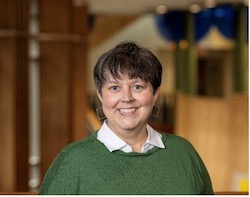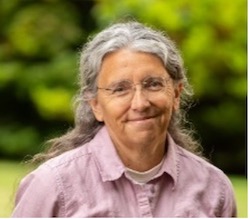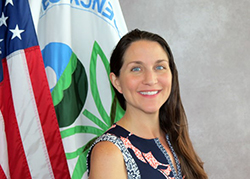Climate Change and Health: Session III - Documenting Exposures and Promoting Health
Sponsored by: NIEHS Superfund Research Program
The NIEHS Superfund Research Program (SRP) is hosting a Risk e-Learning webinar series focused on scientific research and tools that can be used to promote health and resilience to climate change.
The series will feature SRP-funded researchers, collaborators, and other subject-matter experts who aim to better understand and address how climate change affects human exposures to hazardous substances and the public health consequences of a changing climate and identify ways to build health resilience.
The third and final session will highlight how climate-related disasters, and exposure to harmful chemicals redistributed during these events, affect people's health and well-being. Presenters will describe how certain populations are disproportionately exposed to harmful contaminants. Speakers will also share innovative tools to track environmental exposures and improve public health.
Hurricanes are most devastating natural disasters, which dramatically change the physical landscape and take a heavy toll on human life, demolish infrastructure and property, and exacerbate environmental stressors that persists for months after their landfall. Naresh Kumar, Ph.D., of the University of Miami, will examine the distribution of polychlorinated biphenyls (PBCs) and heavy metals in the aftermath of hurricane Maria, which struck Puerto Rico in 2017, and their associated health risks to communities in Guánica Municipality. His team has been monitoring PCBs in Guánica Bay since 2013. Their data suggest that PCB concentration in Bay increased four time after hurricane Maria, and communities PCB exposure through inhalation and ingestion could have likely increased after the hurricane through ingestion and inhalation, because some of the community members rely on the Bay for seafood and fish.
Deborah Watkins, Ph.D., of the University of Michigan School of Public Health and the Northeastern University SRP Center, will discuss the effect of Hurricane Maria on the PROTECT birth cohort in Puerto Rico. She will characterize changes in exposure to environmental contaminants among pregnant participants, comparing biomarker concentrations in samples collected before Hurricane Maria to levels in the weeks and months following the storm. Potential sources of hurricane-related exposures, such as drinking water and exhaust from gas-powered generators, as well as methods for linking exposures to adverse birth outcomes, will be discussed.
Kim Anderson, Ph.D., of the Oregon State University SRP Center will talk about three different studies related to Arctic, wildfire, and hurricane cases. The first one is a collaboration with the Yupik community, this study utilized passive sampling devices deployed at eight locations in Troutman Lake, Alaska. Air, water and sediment pore-water deployed samplers were analyzed for 63 alkyl and unsubstituted polycyclic aromatic hydrocarbons (PAHs), 43 brominated and organophosphate flame retardants and 52 polychlorinated biphenyls (PCBs). For the second study, they investigated vapor-phase polycyclic aromatic hydrocarbons (PAHs) in indoor and outdoor air before, during and after wildfires using a community-engaged research approach. Paired passive air samplers were deployed at fifteen locations across four states. Twelve unique PAHs were detected only in outdoor air during wildfires. Indoor PAH concentrations were higher in 77% of samples across all sampling events. Even during wildfires, 58% of sampled locations still had higher indoor PAH air concentrations. Cancer and non-cancer inhalation risk estimates from vapor-phase PAHs were higher indoor than outdoor, regardless of wildfire impact. Consideration of indoor air quality and vapor-phase PAHs could inform public health recommendations regarding wildfires. The third study is related to Hurricane Harvey, which was associated with flood-related damage to chemical plants, oil refineries, and flooding of hazardous waste sites, including 13 Superfund sites. As clean-up efforts began, concerns were raised regarding the human health impact of possible increased chemical exposure resulting from the hurricane and subsequent flooding. Personal sampling devices in the form of silicone wristbands were deployed to a longitudinal panel of individuals within 45 days of the hurricane and again one year later in the Houston metropolitan area. Personal chemical exposures were generally higher post-hurricane Harvey. These three artic, wildfire, and hurricane studies found that chemicals are moving in different ways and chemical exposures change with the disasters.
This webinar is the third in a three-part series, please visit the pages for Session I and Session II to register and learn more.
 Naresh Kumar, Ph.D., University of Miami (nkumar@med.miami.edu)
Naresh Kumar, Ph.D., University of Miami (nkumar@med.miami.edu)
Naresh Kumar, PhD, is Professor of Environmental Health and Biostatistics in the Miller School of Medicine at the University of Miami (UM). He also directs the graduate program in Climate and Health at the University of Miami. His research focus is on developing personalized exposure and its associated health risk with the aid of time-space modeling and real-time sensors his team has developed. He also pursues research on how climate and extreme weathers exacerbate the health effects of environmental stressors. He has published extensively on the health effects of environmental pollutants and time-space modeling with a major focus on health effects of air pollution. His research findings and real-time health risk surveillance allows him to engage individuals and communities at risk, and other stakeholders in preventive measures to mitigate the adverse health risk of environmental stressors. For example, his research on polychlorinated biphenyls in in Guánica Bay, PR and its associated risk to communities has guided EPA to consider Guánica Bay to be added to the National Priority List. His research has been supported by NIH, NSF And EPA.
 Deborah Watkins, Ph.D., University of Michigan/ Northeastern University SRP Center (debjwat@umich.edu)
Deborah Watkins, Ph.D., University of Michigan/ Northeastern University SRP Center (debjwat@umich.edu)
Deborah Watkins, Ph.D., is a Research Associate Professor of Environmental Health Sciences (EHS) at the University of Michigan School of Public Health (UMSPH). As a member of the SRP Center at Northeastern University, she is investigating the impact of chemical exposures during pregnancy on adverse birth outcomes and child development in an ongoing birth cohort in Puerto Rico.
 Kim Anderson, Ph.D., Oregon State University SRP Center (kim.anderson@oregonstate.edu)
Kim Anderson, Ph.D., Oregon State University SRP Center (kim.anderson@oregonstate.edu)
Kim Anderson, Ph.D., is a professor and Head of the Department of Environmental and Molecular Toxicology at Oregon State University. She directs the Food Safety and Environmental Stewardship Program at OSU. Dr. Anderson is a Project and Core leader in the NIEHS Superfund Research Program at Oregon State University. Dr. Anderson has been developing passive samplers since 1999, and in 2008 developed the personal silicone wristband sampler technology to measure an individual chemical exposure. Dr. Anderson is interested in developing systematic personal chemical exposure surveys of an individual’s chemical exposures to better understand connections between chemical exposures, and health outcomes. She is also a founding member of MyExposome, Inc., an early stage start-up company focusing on innovative technologies for monitoring individual environmental exposure with passive monitoring devices.
Moderators:
 Richard Kwok, Program Director in the Office of the Director, Office of Scientific Coordination, Planning, and Evaluation (SCOPE), National Institute of Environmental Health Sciences (richard.kwok@nih.gov)
Richard Kwok, Program Director in the Office of the Director, Office of Scientific Coordination, Planning, and Evaluation (SCOPE), National Institute of Environmental Health Sciences (richard.kwok@nih.gov)
Richard Kwok, Ph.D., is a Program Director in the Office of the Director, Office of Scientific Coordination, Planning, and Evaluation (SCOPE) at NIEHS. He focuses on health outcomes following both natural and anthropogenic disasters through the Disaster Research Response (DR2) Program. He works closely on implementation of data harmonization and data integration efforts across the environmental health sciences. He maintains a secondary appointment in the Epidemiology Branch at NIEHS and is an Investigator for the GuLFSTUDY. The study focuses on the potential health effects of clean-up workers, volunteers, and community members from the Deepwater Horizon disaster. Kwok specializes in the environmental causes of a range of diseases, and the pervasive nature of the environment in disease etiology has allowed him to work on a number of different projects with domestic and international collaborators from federal, academic, and industry sectors.
 Jean Balent, U.S. EPA Technology Innovation and Field Services Division (balent.jean@epa.gov or 202-566-0832)
Jean Balent, U.S. EPA Technology Innovation and Field Services Division (balent.jean@epa.gov or 202-566-0832)
Ms Balent is on the staff of the EPA's Technology Innovation and Field Services Division where she has worked to collect and disseminate hazardous waste remediation and characterization information since 2003. Ms Balent manages the Clean Up Information Network website and actively supports online communication and collaboration resources available to EPA. She formerly worked with the US Army Corps of Engineers Environmental Engineering Division in the Buffalo District. Ms Balent was also a member of the SUNY-Buffalo Groundwater Research Group where she constructed and tested large scale models of groundwater flow. Ms Balent has also conducted research relating to the Great Lakes, environmental remediation, and brownfields re-development. She holds a Bachelor's degree in environmental engineering from SUNY-Buffalo and a Master's degree in Information Technology from AIU.
Webinar Slides and References:
-
 Slide Presentation for Naresh Kumar, Ph.D. (11.2MB/PDF)
Slide Presentation for Naresh Kumar, Ph.D. (11.2MB/PDF)
-
 Slide Presentation for Deborah Watkins, Ph.D. (3.97MB/PDF)
Slide Presentation for Deborah Watkins, Ph.D. (3.97MB/PDF)
-
 Slide Presentation for Kim Anderson, Ph.D. (3.40MB/PDF)
Slide Presentation for Kim Anderson, Ph.D. (3.40MB/PDF)
Additional Resources:
- Visit the NIEHS Superfund Research Program (SRP) Risk e-Learning page to learn more about this webinar series.
- Email srpinfo@mail.nih.gov to be added to the SRP Risk e-Learning listserv.
- SRP December 2021 Science Digest on Climate Change
- Adapting to Climate Change: Leveraging Systems-Focused Multidisciplinary Research to Promote Resilience
Thank you for participating in our webinar. We would like to receive any feedback you might have that would make this service more valuable.
Help & FAQs
- Frequently Asked Questions
- Content Questions?
Call Mali Velasco Delgado at 919-794-4708 or mali.velascodelgado@nih.gov - Technical Problems?
Leave us a comment - Cancel Your Registration
- My Participation Records
- CEU Credits and PDHs
Zoom Resources
This seminar will be delivered through Zoom. Participants are encouraged to update to the latest version of the Zoom application for the best experience. If you are unable to install the Zoom application, most functions will be available if you join just using a modern web browser such as Chrome, Edge or Firefox. We strongly encourage you to run the Zoom Meeting Test prior to attending this seminar. Technical support on the day of the seminar will be very limited and subject to significant delays.
Rehabilitation Act Notice for Reasonable Accommodation
It is EPA's policy to make reasonable accommodation to persons with disabilities wishing to participate in the agency's programs and activities, pursuant to the Rehabilitation Act of 1973, 29 U.S.C. 791. Any request for accommodation should be made to at or , preferably one week or more in advance of the seminar, so that EPA will have sufficient time to process the request. EPA would welcome specific recommendations from requestors specifying the nature or type of accommodation needed. EPA welcomes specific recommendations from requestors specifying the nature or type of accommodation needed. Please note that CLU-IN provides both alternate phone call-in options and closed captioning for all webinars, and requests for these specific accommodations are not necessary.
Rehabilitation Act Notice for Reasonable Accommodation
It is EPA's policy to make reasonable accommodation to persons with disabilities wishing to participate in the agency's programs and activities, pursuant to the Rehabilitation Act of 1973, 29 U.S.C. 791. Any request for accommodation should be made to at or , preferably one week or more in advance of the webinar, so that EPA will have sufficient time to process the request. EPA would welcome specific recommendations from requestors specifying the nature or type of accommodation needed. EPA welcomes specific recommendations from requestors specifying the nature or type of accommodation needed. Please note that CLU-IN provides both alternate phone call-in options and closed captioning for all webinars, and requests for these specific accommodations are not necessary.
Webinar Recording
By participating in this CLU-IN webinar, you automatically agree to authorize recording of audio and visual content presented during this live event and consent to subsequent use of this recording in the public domain by the U.S. Environmental Protection Agency. This recording may include questions, comments and poll responses provided by you during the live event in addition to your name, voice, image or likeness. This recording will be made available after the conclusion of the live event as part of the CLU-IN webinar archives, and will remain available indefinitely. If you do not wish to consent to the recording, please do not join the live event, and contact Jean Balent at 202-566-0832 or balent.jean@epa.gov to discuss your concerns.
Content Disclaimer
This webinar is intended solely to provide information to the public. The views and opinions expressed as part of this webinar do not necessarily state or reflect those of the U.S. Environmental Protection Agency. It is not intended, nor can it be relied upon, to create any rights enforceable by any party in litigation with the United States, or to endorse the use of products or services provided by specific vendors. With respect to this webinar, neither the United States Government nor any of their employees, makes any warranty, express or implied, including the warranties of merchantability and fitness for a particular purpose, or assumes any legal liability or responsibility for the accuracy, completeness, or usefulness of any information, apparatus, product, or process disclosed, or represents that its use would not infringe privately owned rights.

